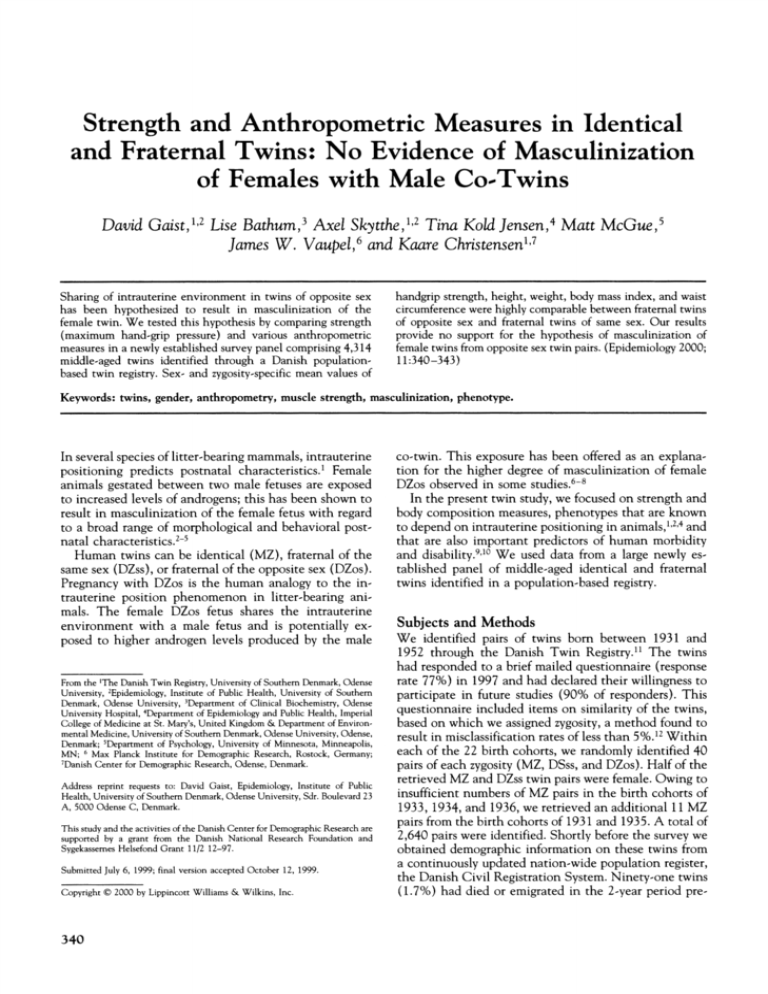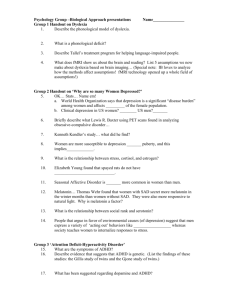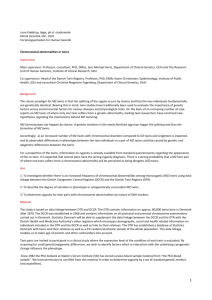Strength and Anthropometric Measures in Identical and Fraternal
advertisement

Strength and Anthropometric Measures in Identical and Fraternal Twins: No Evidence of Masculinization of Females with Male Co-Twins Tina KoldJensen,4Matt McGue,5 David Gaist,1,2Lise Bathum,3Axel Skytthe,1'2 JamesW. Vaupel,6and KaareChristensen1'7 environmentin twinsof oppositesex Sharingof intrauterine of the has been hypothesizedto result in masculinization femaletwin.We testedthis hypothesisby comparingstrength (maximumhand-grippressure)and variousanthropometric measuresin a newlyestablishedsurveypanelcomprising 4,314 middle-agedtwins identifiedthrougha Danish populationmeanvaluesof basedtwin registry.Sex- and zygosity-specific handgripstrength,height,weight,bodymassindex,andwaist circumference werehighlycomparable betweenfraternaltwins of oppositesex and fraternaltwins of same sex. Our results of provideno supportfor the hypothesisof masculinization femaletwinsfromoppositesex twinpairs.(Epidemiology 2000; 11:340-343) Keywords: twins, gender, anthropometry, muscle strength, masculinization, phenotype. In severalspecies of litter-bearingmammals,intrauterine positioning predicts postnatal characteristics.' Female animals gestated between two male fetuses are exposed to increasedlevels of androgens;this has been shown to result in masculinizationof the female fetus with regard to a broad range of morphologicaland behavioral postnatal characteristics.2-5 Human twins can be identical (MZ), fraternalof the same sex (DZss), or fraternalof the opposite sex (DZos). Pregnancywith DZos is the human analogy to the intrauterine position phenomenon in litter-bearing animals. The female DZos fetus shares the intrauterine environment with a male fetus and is potentially exposed to higher androgen levels produced by the male Fromthe 'The Danish Twin Registry,University of Southern Denmark,Odense University, 2Epidemiology,Institute of Public Health, University of Southern Denmark, Odense University, 3Departmentof Clinical Biochemistry, Odense University Hospital, 4Departmentof Epidemiologyand Public Health, Imperial College of Medicine at St. Mary's,United Kingdom& Departmentof Environmental Medicine, University of Southern Denmark,Odense University, Odense, Denmark; 5Departmentof Psychology, University of Minnesota, Minneapolis, MN; 6 Max Planck Institute for Demographic Research, Rostock, Germany; 7DanishCenter for DemographicResearch, Odense, Denmark. Address reprint requests to: David Gaist, Epidemiology, Institute of Public Health, University of Southern Denmark,Odense University, Sdr. Boulevard23 A, 5000 Odense C, Denmark. This study and the activities of the Danish Center for DemographicResearchare supported by a grant from the Danish National Research Foundation and SygekassemesHelsefond Grant 11/2 12-97. Submitted July 6, 1999; final version accepted October 12, 1999. Copyright ? 2000 by Lippincott Williams & Wilkins, Inc. 340 co-twin. This exposure has been offered as an explanation for the higher degree of masculinizationof female DZos observed in some studies.6-8 In the present twin study, we focused on strength and body composition measures,phenotypes that are known to depend on intrauterine positioning in animals,'2'4 and that are also important predictorsof human morbidity We used data from a large newly esand disability.9'10 tablished panel of middle-aged identical and fraternal twins identified in a population-basedregistry. Subjectsand Methods We identified pairs of twins born between 1931 and 1952 through the Danish Twin Registry.1 The twins had respondedto a brief mailed questionnaire(response rate 77%) in 1997 and had declaredtheir willingness to participate in future studies (90% of responders).This questionnaireincluded items on similarityof the twins, based on which we assignedzygosity,a method found to result in misclassificationratesof less than 5%.12Within each of the 22 birth cohorts, we randomlyidentified 40 pairsof each zygosity(MZ, DSss, and DZos). Half of the retrievedMZ and DZsstwin pairswere female. Owing to insufficient numbersof MZ pairs in the birth cohorts of 1933, 1934, and 1936, we retrievedan additional 11 MZ pairsfrom the birth cohorts of 1931 and 1935. A total of 2,640 pairswere identified. Shortly before the surveywe obtained demographicinformationon these twins from a continuously updatednation-wide population register, the Danish Civil RegistrationSystem. Ninety-one twins (1.7%) had died or emigrated in the 2-year period pre- OF MASCULINIZATION OF FEMALES WITHMALECO-TWINS 341 Epidemiology May 2000, Vol. 11 No. 3NO EVIDENCE were considerednot possible to contact only when at least three unsuccessful attempts to contact them at their residence were made. To avoid interviewer bias, which would inflate twin similarity, twins from a pair were never interviewed by the same interviewer. A pilot study testing all procedures resulted in minor TheDanishTwinRegistry 5,280twinsborn1931-52 the 91 twinsdeadoremmigrated during yearbeforethestudy V twins 4,314 pa rticipating 5,189 eligible twins Intact twin pairs MZ male MZ female DZss male DZss female 420 427 DZos 846 All Broken twin pairs* MZ male MZ female DZss male DZss female Intact twin pairs MZmale MZfemale N 431 427 83.1% Overall participation 2,551 9 12 DZss maile DZss fennale 312 74.3 291 68.1 DZos 617 72.9 All 'i Singletwinpairs MZmale lie MZfema DZssmaale DZssfer 20 13 changes N % of eligible pairs 335 77.7 329 77.0 1,884 73.9 188 73.9 574 57 102 only. We compared participants and non-partici- pants with regard to age, gender, urban residency, and marital status using data from the Civil Registration System. Height in centimeters and weight in kilograms were self-reported and were used to calculate the body mass index (weight/height2 kg/ With a tape measure, m2). DZos 33 DZos 214 the interviewers took two All 87 All 546 measurements of the sub- jects' waist circumference between the lowest rib margin and the iliac crest and recordedthe values to Danishtwins. FIGURE 1. Eligibility and participation in the study of miiddle-aged the closest 0.1 cm. The average of the two measures was used in this analysis.Forgrip strength, we identified ceding the study, leaving 5,189 twins eligible for particthe in the maximumvalue among the recordedmeasurements study. ipation Interviews were conducted by a total of 100 inter(three for each hand for 97.8% of the sample). viewers from the Danish National Institute of Social Research, an approachpreviouslyused in twin research projects.13The survey, which lasted on average 11/2 Results hours, compriseda questionnaire,tests of cognitive and Eighty-fivepercent of male and 81.3% of female eligible twins participated (Figure 1). Comparedwith non-parphysical functioning, and sampling of DNA. All interviewersreceived a detailed training program ticipants, participantswere slightly younger, more frequently married,and lived less frequentlyin urbanareas by a physician and were closely monitored in the 6-month period (October 1998 through March 1999) (Table 1). These differencesremainedwhen the sample The twins the interviews were was stratifiedby zygosity (results not shown). Pair-wise which during completed. Theco-twinwas eitherdead or had emmigrated. twinpairsinwhichonlyonetwinwaseligibleforparticipation. *Broken: brokentwinpairorco-twindidnotwishto participate. **Single: TABLE 1. Characteristics of Participants and Non-Participants in the Study of Middle-Aged Danish Twins (N = 5,189) One Twin BothTwins One Twin BothTwins Participants Non-Participants Participant* Non-Participantt Participants* Non-Participantst N = 875 N = 4,314 N = 366 N = 546 N = 509 N = 3,768 Age,t mean(SD) Male,% Urbanresidency,?% Married,% 56.9 (6.3) 50.7 26.0 77.2 57.9 (6.3) 37.7 28.1 73.0 57.1 (6.4) 52.6 30.6 75.6 * Includes62 twinsfromtwinpairswhereonlyone twinwaseligibleforparticipation. t Includes25 twinsfromtwinpairswhereonlyone twinwaseligibleforparticipation. t As of January1, 1999. ? Definedas residencyin boroughwith500 or moreinhabitants perkm2. 56.6 (6.4) 49.1 33.0 69.4 56.9 (6.3) 51.0 26.6 77.0 57.2 (6.4) 44.3 31.0 70.9 342 Gaistet al Epidemiology May2000, Vol. 11 No. 3 TABLE 2. Mean Values (Standard Deviations) of Handgrip Strengthand Body Composition Components by Gender and Zygosity in 4,22 3 Middle-Aged Danish Twins Identical Twins Male N Age, years Height, cm Weight, kg Body mass index, kg/m2 Waist circumference,cm Maximum handgrip,kg Female N Age, years Height, cm Weight, kg Body mass index, kg/m2 Waist circumference,cm Maximum handgrip,kg FraternalTwins Same Sex 734 56.9 (6.4) 176.1 (6.5) 80.4 (11.3) 25.9 (3.2) 97.8 (9.7) 47.4 (8.2) 709 56.8 (6.4) 176.5 (6.5) 81.3 (11.7) 26.1 (3.3) 98.6 (10.3) 47.9 (8.2) 703 56.9 (6.4) 164.0 (5.8) 65.4 (10.7) 24.3 (3.9) 85.1 (11.7) 27.1 (5.7) 655 56.7 (6.3) 164.8 (5.8) 65.9 (11.7) 24.2 (3.9) 85.1 (11.9) 28.2 (5.8) participation was greater for MZ pairs (77%) than DZ pairs (72%). After exclusion of twins with missing values on variables of interest, the sample was reduced to 4,223 twins (97.9%). The mean age of these subjectswas 56.9 years (SD = 6.3) and varied 0.3 years or less in sex and zygosity strata (Table 2). Mean values and standard deviations for grip strength and body composition were virtuallyidentical for MZ, DZss, and DZos in both males and females. In particular, the mean values of female DZos for all measuresdifferedby less than 1% from the correspondingmeans for other female twins (MZ and DZss), and the differenceswere not consistently in one direction. Discussion Animal studies provide strong support for masculinization of female fetuses placed between males in utero. Nevertheless, the resultsof this study are not consistent with the hypothesis of masculinizationof human female DZos. In this large sample of twins, members of DZos pairswere strikinglysimilarto MZ and DZssof the same sex with respect to an objective measureof strength and anthropometricmeasures. Previousstudiesof the potential masculinizationof human female DZos have yielded conflicting results with respect to physicaland physiologicvariables.Boklagereported an intermediategender phenotype with regardto craniofacialgrowthfor DZostwins.14McFaddenreporteda masculinizedpatter of spontaneousotoacousticemissions in female DZos comparedwith female DZss and female non-twins.6Studiesof birthweighthave yieldedconflicting results.15"17 In a sampleof Australianfemale twins, height and some items relatedto reproductivefunctionsshowed minor effects consistent with a masculinizationof female DZos.18In a largeDanish study,fecundabilitymeasuredby waitingtime to firstever pregnancydid not differby zygosity or sex of co-twin.19 Studies of behavioraltraits, such as sensation seeking7 and attitudes,8seem to show more consistent results in Fratemal Twins l T s Opposite Sex favor of a more masculine phenotype in DZos. However, the effects of rearing (female DZos growing up with a brother) and intrauterine exposures cannot be adequately discerned in these studies. Physical and physiological measuresmay in fact also be con722 57.0(6.3) founded by the effects of psychosocial 176.7(7.0) rearing in DZos twins, an effect we 80.7(11.5) would expect to be less pronouncedin 25.9(3.3) 98.0(9.6) a Danish setting, which is character48.2(8.7) ized by minimal class variability and sexism. If such confounding is present, 700 56.9(6.3) however, we would expect it to bias 164.9 female DZos phenotypes toward a 66.0(11.0) (61.) greater similarity with male pheno24.3(3.9) 85.1(11.8) types. Clearly this is not the case in the present study. The participation rate in the present studywas high. Non-participation was not highly selected, but showed patterns recognized from other studies:a tendency for lower participation of fraternaltwins, personswho were not married, and urban area dwellers. Interestingly,males were more likely to participatein this as well as in previousDanish twin studies,13'20 a pattern opposite to what we expected from the literature.21 In conclusion, the data of this large study of twins using both objective measurements and self-reported data provide no evidence of a more masculinizedphenotype in female DZos. References 1. vom Saal SF. Sexual differentiationin litter-bearingmammals:influence of sex of adjacent fetuses in utero.J Anim Sci 1989;67:1824-1840. 2. KinsleyC, Miele J, WagnerCK, GhiraldiL, BroidaJ, SvareB. Prior 3. 4. 5. 6. 7. intrauterineposition influences body weight in male and female mice. Horm Behav 1986;20:201-211. Kinsley C, Miele J, Konen C, Ghiraldi L, Svare B. Intrauterinecontiguity influences regulatoryactivity in adult female and male mice. Horm Behav 1986;20:7-12. ForgerNG, Galef BGJ,Clark MM. Intrauterineposition affectsmotoneuron numberand muscle size in a sexuallydimorphicneuromuscularsystem. Brain Res 1996;735:119-124. Khan MZ, Foley GL. Retrospective studies on the measurements,karyotyping and pathology of reproductive organs of bovine freemartins.J Comp Pathol 1994;110:25-36. McFadden D. A masculinizing effect on the auditory systems of human females having male co-twins. Proc Natl Acad Sci USA 1993;90:1190011904. Resnick SM, Gottesman II, McGue M. Sensation seeking in opposite-sex twins:an effectof prenatalhormones? BehavGenet 1993;23:323-329. 8. Miller EM, Martin N. Analysis of the effect of hormones on opposite-sex twin attitudes. Acta Genet Med Gemellol (Roma) 1995;44:41-52. 9. Rantanen T, Guralnic JM, Foley D, Masaki K, Leveille S, Curb JK, White L. Midlife hand grip strength as a predictor of old age disability. JAMA 1999;281:558-560. 10. LeanMEJ,HanTS, SeidellJC.Impairment of healthandqualityof life in Lancet1998;351:853-856. peoplewith largewaistcircumference. 11. KyvikKO,Christensen K, SkyttheA, HarvaldB, HolmNV. The Danish Twin Register. Dan Med Bull 1996;43:467-470. 12. Hauge M. The Danish Twin Register. In: Mednick SA, BaertAE, Backman BP, eds. Prospective longitudinal research:An empirical basis for the primaryprevention of psychosocialdisorders.London:OxfordUniversity Press, 1981;218-221. 13. Christensen K, Holm NV, McGue M, Corder L, Vaupel JW. A Danish population-basedtwin studyon generalhealth in the elderly.J Aging Health 1999;11:49-64. OF MASCULINIZATION OF FEMALES WITHMALECO-TWINS 343 Epidemiology May 2000, Vol. 11 No. 3NO EVIDENCE 14. BoklageCE. Interactionsbetweenopposite-sexdizygoticfetusesand the of Weinbergdifferencemethodepidemiology. Am J Hum assumptions Genet 1985;37:591-605. 15. CoreyLA, NanceWE,KangKW,ChristianJC.Effectsof typeof placentationon birthweight in monozygotic anddizygotictwins. andits variability ActaGenetMedGemellol(Roma)1979;28:41-50. 16. GlinianaiaSV, MagnusP, HarrisJR,TambsK. Is therea consequence for fetalgrowthof havingan unlike-sexed cohabitantin utero?IntJ Epidemiol 1998;27:657-659. 17. OrlebekeJF,van BaalGC, BoomsmaDI, NeelemanD. Birthweightin oppositesex twinsas comparedto samesex dizygotictwins.EurJ Obstet Gynecol Reprod Biol 1993;50:95-98. 18. Loehlin JC, Martin NG. A comparisonof adult female twins from oppositesex and same-sex pairs on variables related to reproduction.Behav Genet 1998;28:21-27. 19. Christensen K, Basso O, Kyvik KO, Juul S, Boldsen J, Vaupel JW, Olsen J. Fecundabilityof female twins. Epidemiology1998;9:189-192. 20. Andersen-RandbergK, Christensen K, Jeune B, Skytthe A, VasegaardL, Vaupel JW. Activity of daily living among elderly and oldest-old in Denmark.Age Ageing 1999;28:373-377. 21. LykkenDT, McGue M, Tellegen A. Recruitmentbias in twin research:the rule of two-thirds reconsidered.Behav Genet 1987;17:343-362. IEA EUROPEANREGIONALMEETING Satellite Seminar Future of Epidemiology II 24 August 2000 at 09:00-16:00h KaunasUniversity of Medicine, Central Building, Mickeviciaus str. 9, LT-3000 Kaunas,Lithuania Opening:(Prof.Jom Olsen, Denmark) PublicHealthEpidemiology:(Prof. Neil Pearce, New Zealand) EcosocialSciencePerspective:(Prof. Nancy Krieger,United States of America) Epidemiology:(Dr. Timo Partanen, Finland) Environmental/Occupational ClinicalEpidemiology:(open) MolecularEpidemiology:(Prof. Paolo Vineis, Italy) GeneticEpidemiology:(Prof. Kari Hemminki, Sweden) in Centraland EasternEurope:(Prof. Vilius Grabauskas,Lithuania) Epidemiology in DevelopingCountries:(Dr. Catharina Wesseling, Costa Rica) Epidemiology (Dr. Esther Welp, the Netherlands) Expectationsof YoungEpidemiologists: and Ethics: Rodolfo Saracci, (Prof. Italy) Equity RoundTableDiscussion WHOview andQuestions Comments fromtheAudience Conclusion IEA EUROPEANREGIONALMEETING "From Molecules to Public Health" 25-26 August 2000 at 8:30-17:30h KaunasVytautasMagnusUniversity, Daukantostr. 28, LT-3000Kaunas,Lithuania FRIDAY25 AUGUST, 2000 Keynotelectures: "Socialinequalities andhealthin changing Europe"(open) in processes "Ageing populations" European (Prof.JamesW. Vaupel,Denmark) Keynote lectures: SATURDAY 26 AUGUST, 2000 in diseasesurveillance "Monitoring requirements system" (Dr. RuthBonita,Switzerland) in healthpromotion anddiseaseprevention" "Community approaches (Prof.PekkaPuska,Finland) http://www.info.kma.lt/EUROIEA2000







